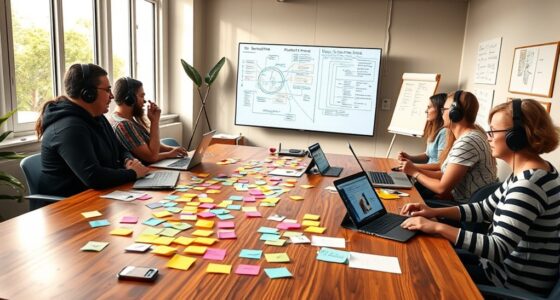Applying Lean UX principles to your startup helps you focus on rapid experiments, user feedback, and continuous learning. You can identify customer needs through interviews and observations, then build quick prototypes to test ideas efficiently. Collaborate across teams, prioritize experiments, and track meaningful metrics to avoid waste. Cultivating a learning culture ensures adaptability and growth. If you explore further, you’ll discover how to implement these principles effectively for your startup’s success.
Key Takeaways
- Focus on rapid experimentation and iterative design based on real user feedback to minimize waste.
- Conduct user interviews and observations to uncover customer needs and pain points effectively.
- Build low-fidelity prototypes to quickly test ideas and gather actionable insights for continuous improvement.
- Foster cross-functional collaboration and a culture of learning to adapt strategies swiftly.
- Implement automated testing and prioritize high-impact experiments to accelerate product-market fit validation.
Understanding the Core Concepts of Lean UX

What exactly are the core ideas behind Lean UX, and why do they matter for startups? Lean UX focuses on rapid experimentation, collaboration, and continuous learning to develop better products efficiently. It emphasizes minimizing waste by avoiding lengthy upfront planning and instead iterating quickly based on real user feedback. When applying Lean UX, you prioritize design aesthetics that resonate with your target audience and reinforce your branding strategies, ensuring your product’s look and feel align with your brand identity. This approach encourages you to test ideas early, refine designs iteratively, and stay flexible throughout development. Additionally, understanding the psychological and neurological aspects of dreaming can inspire innovative ways to approach problem-solving and creativity in product design. Recognizing how brain processes influence creativity can help startups foster more effective innovation and user engagement. Incorporating user-centered design principles further ensures that your development efforts remain aligned with actual user needs, improving overall product success. By doing so, you reduce risks, save resources, and create a user experience that genuinely connects with users—crucial for startup success in a competitive market. Understanding how visual perception impacts user interactions can further enhance your design strategies and overall product appeal. Recognizing the importance of user feedback can also help refine your product based on real-world insights.
Identifying Customer Needs and Pain Points

To identify customer needs and pain points, you should start by conducting user interviews to gather direct feedback. Observing user behavior helps you see how they interact with your product in real-world settings. Mapping user journeys reveals where frustrations occur and highlights opportunities for improvement. Considering industry trends strategies can also inform product development by addressing varied customer risk tolerances. Additionally, analyzing the performance enhancements of similar products in the market can provide insights into features that resonate with users and areas that require innovation. Incorporating user feedback from multiple sources ensures a comprehensive understanding of customer needs. Recognizing skin type sensitivities can further tailor your approach to meet diverse user requirements effectively.
Conduct User Interviews
Conducting user interviews is a vital step in uncovering genuine customer needs and pain points that often go unnoticed through assumptions alone. These conversations deepen your understanding of user engagement and help refine your branding strategies. During interviews, focus on asking open-ended questions to gather honest insights. Keep the dialogue natural to encourage openness and trust. Remember, your goal is to listen actively and avoid leading responses. Effective interviews reveal underlying frustrations and motivations, informing product improvements. To maximize value:
- Prepare targeted questions ahead of time
- Focus on user experiences, not just features
- Observe tone and body language for additional clues
- Validate assumptions with real user feedback
- Use insights to tailor your branding and engagement efforts
- Incorporate mindfulness and active listening techniques to better interpret user responses to foster deeper understanding. Engaging in mindfulness practices can enhance your ability to interpret subtle cues during conversations. This approach guarantees your startup aligns more closely with customer needs, boosting satisfaction and loyalty. Recognizing the importance of data privacy challenges in understanding user concerns can also help you address potential reservations early in the development process. Additionally, understanding support hours and how they vary can help you better schedule interviews and follow-ups to ensure timely feedback. Being aware of fetal movements trends can also help you better interpret user feedback during early research phases.
Observe User Behavior
Observing user behavior provides immediate, real-world insights into how customers interact with your product or service. By watching users, you can identify pain points and unmet needs that may not surface through interviews alone. Conduct heuristic analysis during these observations to evaluate usability and uncover design flaws that hinder user flow. Pay attention to aesthetic evaluation, noting how visual elements influence engagement and frustration. Notice where users hesitate, struggle, or abandon tasks, revealing opportunities for improvement. This hands-on approach helps you understand the actual experience, rather than relying solely on assumptions. Incorporating usability testing into your observation process allows you to systematically assess how users navigate your product and identify specific areas for enhancement. Recognizing user engagement patterns can also guide your design iterations and improve overall satisfaction. Combining behavioral observation with heuristic analysis and aesthetic evaluation gives you a clearer picture of what truly resonates with users and where their frustrations lie, guiding your next design decisions. Additionally, observing user interaction patterns can reveal insights into emotional responses and engagement levels that are crucial for creating compelling user experiences. Conducting continuous user feedback ensures your insights remain relevant and actionable throughout the development process. Moreover, understanding retail hours can help tailor user experiences to align with customer availability and preferences.
Map User Journeys
Mapping user journeys builds directly on observing user behavior by helping you visualize how customers interact with your product step-by-step. This process enhances persona development by revealing real needs and pain points. Use visual storytelling to create clear, engaging maps that highlight key moments and emotions throughout the user experience. Focus on identifying moments of frustration, delight, or confusion to better understand customer motivations. To do this effectively, consider:
- Chart each step users take when engaging with your product
- Highlight touchpoints where users encounter issues
- Identify opportunities for improvement or innovation
- Incorporate user feedback to refine personas and journeys
- Use visual storytelling to communicate insights clearly
- Recognize the importance of cultural nuances in understanding diverse customer behaviors and preferences
- Additionally, understanding technical factors like solar panel orientation and maintenance can inform how users interact with energy-related products or services, revealing further opportunities for user-centered design.
- Conducting a life cycle analysis can help identify environmental impacts at each stage, guiding more sustainable design decisions.
- Exploring popular juice brands and their health-conscious options can also inspire user-centric product features that appeal to wellness-focused customers.
Building Cross-Functional, Collaborative Teams

Building cross-functional, collaborative teams is essential for applying Lean UX principles effectively in startups. When you foster diverse teams, you tap into a variety of skills and perspectives, which boosts team motivation and accelerates problem-solving. To succeed, you need to adapt your leadership styles—encouraging open communication and shared ownership. Promote a culture where everyone feels empowered to contribute, regardless of their role. This approach minimizes silos and enhances collaboration, allowing ideas to flow freely. Your goal is to create an environment where team members trust each other and work towards common goals. By cultivating cross-disciplinary partnerships, you ensure faster iteration cycles and more innovative solutions, aligning your team’s efforts with Lean UX’s core principles. Incorporating vetting processes for team products can further enhance your team’s effectiveness and safety.
Developing Rapid Prototypes for Testing Ideas

Developing rapid prototypes is a vital step in testing ideas quickly and efficiently. Rapid prototyping allows you to turn concepts into tangible versions that reveal strengths and weaknesses early. Focus on creating simple, functional models that capture core features without perfection. This approach accelerates idea validation and saves resources. To get started, consider:
Rapid prototyping quickly tests ideas by creating simple, functional models that reveal strengths and weaknesses early.
- Using low-fidelity tools like paper sketches or wireframes
- Prioritizing features for immediate testing
- Gathering quick user feedback for improvements
- Iterating often to refine your prototype
- Avoiding over-polishing in early stages
Emphasizing Continuous User Feedback

You should prioritize regular user engagement to gather meaningful insights throughout your development process. By incorporating iterative design cycles, you can quickly refine your product based on real feedback. Making data-driven decisions guarantees your startup stays aligned with user needs and market demands.
Regular User Engagement
Regular user engagement is essential for startups aiming to refine their products effectively. Staying connected helps you gather continuous feedback, improve user onboarding, and adapt quickly. To foster engagement:
- Use onboarding surveys to understand user expectations
- Implement feature toggles for safe testing of new features
- Encourage users to share feedback through in-app prompts
- Monitor user behavior to identify drop-off points
- Host regular check-ins or webinars for direct interaction
Iterative Design Cycles
Implementing iterative design cycles allows startups to continuously refine their products based on real user feedback. With each cycle, you can improve design aesthetics by addressing user preferences and usability issues, ensuring the product looks and feels appealing. This process also helps maintain branding consistency, reinforcing your startup’s identity throughout updates. By gathering feedback early and often, you identify pain points and adjust features quickly, avoiding costly revisions later. Each iteration offers a chance to test new ideas, validate assumptions, and fine-tune the user experience. This ongoing loop keeps your product aligned with user needs, fostering a more engaging and cohesive interface. Emphasizing continuous improvement helps you build a more user-centric product that evolves with your audience.
Data-Driven Decisions
Data-driven decisions hinge on continuous user feedback, enabling startups to make informed choices that directly impact product success. Regular feedback helps you identify pain points and validate assumptions. Conduct heuristic evaluations to uncover usability issues early, saving time and resources. Use competitive analysis to understand market positioning and identify gaps. Incorporate user surveys and analytics to gather insights quickly. Prioritize features based on real user needs rather than assumptions, ensuring your product stays aligned with user expectations. By integrating ongoing feedback loops, you can adapt swiftly and refine your product effectively. This approach supports a lean methodology, reducing waste and boosting your chances of success in a competitive landscape.
Implementing Iterative Design Cycles

To effectively develop your product, adopting iterative design cycles allows you to quickly test ideas, gather feedback, and refine your solutions. Begin with small prototypes, then evaluate them through heuristic evaluations based on usability heuristics. This process helps identify usability issues early, saving time and resources. Use feedback from each cycle to inform the next iteration, ensuring continuous improvement. Incorporate user testing and heuristic assessments regularly to validate assumptions and uncover hidden problems. Remember, iteration isn’t just about making changes—it’s about learning and adapting swiftly to user needs. Keep your cycles short to stay agile and responsive, enabling rapid evolution of your product.
| Step | Action | Purpose |
|---|---|---|
| Prototype Creation | Build simple versions of your ideas | Test concepts quickly |
| Usability Evaluation | Conduct heuristic evaluation | Identify usability flaws |
| Feedback Integration | Refine based on user feedback | Improve user experience |
| Repeat | Cycle through iterations again | Achieve ideal usability |
Prioritizing Experiments to Minimize Waste

Prioritizing experiments is essential for minimizing waste and making the most of your startup’s limited resources. Focus on the most impactful tests that address key areas like market segmentation and branding strategies. By ranking experiments based on potential value, you avoid chasing low-impact ideas.
Prioritize high-impact experiments to efficiently validate assumptions and conserve startup resources.
Consider these factors to prioritize effectively:
- Impact on your target market segmentation
- Alignment with your branding strategies
- Feasibility of implementation
- Uncertainty reduction for key assumptions
- Expected learning outcomes
This approach helps you validate assumptions quickly, refine your positioning, and allocate resources efficiently. Remember, not every idea warrants immediate testing—choose experiments that clarify your startup’s direction and reduce waste. Prioritization ensures you learn fast and adapt faster, keeping your startup lean and focused.
Measuring Success With Actionable Metrics

Measuring success effectively requires identifying metrics that directly reflect your startup’s goals and progress. Focus on actionable metrics like customer feedback, which reveals how users perceive and interact with your product, guiding meaningful improvements. Tracking design consistency guarantees your team maintains a cohesive user experience, reinforcing brand trust and usability. Avoid relying solely on vanity metrics that don’t influence decision-making. Instead, establish clear benchmarks tied to user behavior and engagement. Regularly analyze customer feedback to uncover patterns and areas for refinement. Use these insights to iterate swiftly, ensuring your product aligns with user needs and your startup’s objectives. By emphasizing these targeted metrics, you’ll gain a clearer understanding of your growth trajectory and make informed decisions that propel your startup forward.
Fostering a Culture of Learning and Adaptation

Fostering a culture of learning and adaptation begins with encouraging your team to embrace experimentation and view failures as opportunities for growth. Create an environment where open communication and curiosity thrive. Use team building exercises to strengthen trust and collaboration, making it easier to share lessons learned. Adjust your office layout to promote transparency, such as open workspaces that facilitate spontaneous discussions. Recognize and celebrate small wins to reinforce a growth mindset. Regularly solicit feedback to identify areas for improvement. Encourage continuous learning through workshops or shared resources. By embedding these practices into your startup’s culture, you make adaptation natural, ensuring your team remains agile and receptive to change.
Scaling Lean UX Practices for Growth

As your startup grows, streamlining cross-functional teams helps keep communication clear and decision-making swift. Automating testing processes saves time and guarantees rapid feedback, allowing you to focus on high-impact experiments. Prioritizing these experiments ensures your team invests effort where it matters most, driving sustained growth.
Streamlining Cross-Functional Teams
To effectively scale Lean UX practices, you need to streamline how cross-functional teams collaborate. Clear communication and aligned goals are essential to maintain design aesthetics and ensure branding consistency across all touchpoints. You can achieve this by:
- Establishing shared terminology to prevent misunderstandings
- Using collaborative tools for real-time updates and feedback
- Regularly syncing on design principles and branding guidelines
- Creating visual standards to unify look and feel
- Encouraging cross-disciplinary input early in the process
This approach minimizes siloed work, accelerates decision-making, and keeps everyone aligned on the user experience. When teams work cohesively, your startup can respond faster to user insights, maintain a consistent brand presence, and scale Lean UX practices effectively.
Automating Testing Processes
Automating testing processes is essential for scaling Lean UX practices efficiently as your startup grows. By implementing automated testing, you guarantee that new features and updates are validated quickly, reducing bugs and maintaining quality. Continuous integration plays a critical role here, allowing you to automatically run tests every time code is committed, catching issues early. This integration streamlines your development cycle, saves time, and minimizes manual testing efforts. As your team expands, automated testing helps keep the workflow smooth and consistent, ensuring rapid delivery of validated features. It also enables you to focus on strategic experiments rather than repetitive tasks. Overall, automating testing and adopting continuous integration are key to maintaining agility and quality at scale.
Prioritizing High-Impact Experiments
Prioritizing high-impact experiments is crucial for scaling Lean UX practices effectively. Focus on tests that directly influence your path to product-market fit and give you a competitive edge. To do this, evaluate ideas based on potential impact and feasibility, ensuring you’re investing in experiments that matter most. Conduct thorough competitive analysis to identify gaps and opportunities where your startup can stand out. Here are key steps to prioritize experiments:
- Assess potential to validate core user needs
- Measure how experiments drive towards product-market fit
- Identify competitive advantages through rapid testing
- Rank ideas by expected impact and effort required
- Focus on experiments that inform strategic decisions
Frequently Asked Questions
How Can Startups Balance Lean UX With Existing Product Development Processes?
You can balance lean UX with your existing product development by integrating design sprints to quickly test ideas and gather user feedback. Focus on rapid, iterative cycles that complement your current processes, allowing you to validate assumptions early without overhauling workflows. Prioritize user-centered decisions, and make certain your team collaborates closely during sprints, making adjustments based on feedback to keep development agile and aligned with user needs.
What Are Common Challenges Faced When Implementing Lean UX in Startups?
Imagine traversing a tightrope, balancing innovation and stability. You often face user resistance, where clients cling to familiar ways, and resource constraints, limiting experimentation. Implementing lean UX in startups means overcoming these hurdles, adapting quickly, and convincing stakeholders to embrace change. Challenges include managing resistance, optimizing limited resources, and maintaining momentum. Yet, with persistence and strategic communication, you can transform these obstacles into opportunities for growth and user-centered success.
How Does Lean UX Adapt to Different Startup Industries or Markets?
When considering industry adaptation and market flexibility, lean UX encourages you to tailor your processes based on your startup’s specific industry needs. You stay agile, quickly adjusting your user research and testing methods to fit different markets. This approach helps you identify what works best in each context, allowing you to remain flexible and responsive to industry trends and customer feedback, ultimately fostering a more effective and adaptable product development strategy.
What Tools Best Support Lean UX Principles for Small Teams?
You wonder which tools support lean UX for small teams? Start with design workshops to foster collaboration and rapid prototyping. Use user journey mapping to understand pain points and opportunities. These tools create momentum, revealing insights quickly. They keep your team aligned, minimize waste, and accelerate your learning. With these, you’ll stay agile, test ideas fast, and adapt seamlessly—turning small moves into big wins in your startup journey.
How Can Startups Sustain Lean UX Practices During Rapid Growth Phases?
During rapid growth, you can sustain lean UX practices by maintaining design consistency across teams, ensuring everyone follows shared principles. Keep gathering user feedback regularly to identify evolving needs and prevent stagnation. Encourage open communication, foster a culture of experimentation, and use lightweight tools that scale with your team. This way, you stay agile, responsive, and aligned with user needs, even as your startup expands.
Conclusion
By embracing Lean UX principles, you streamline your startup’s process, focus on what truly matters, and foster continuous improvement. You understand customer needs, develop rapid prototypes, gather ongoing feedback, and measure success with actionable metrics. You build collaborative teams, prioritize experiments, and cultivate a culture of learning. With these practices, you minimize waste, maximize growth, and adapt swiftly—creating a foundation for sustainable success. Lean UX isn’t just a method; it’s your path to innovation, agility, and growth.









